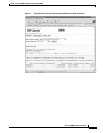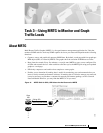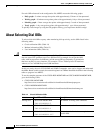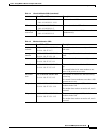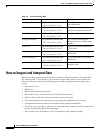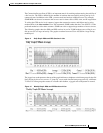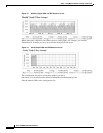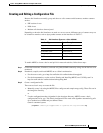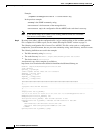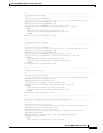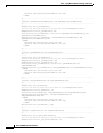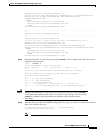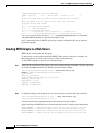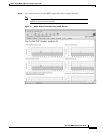
Task 3Using MRTG to Monitor and Graph Traffic Loads
How to Inspect and Interpret Data
#'
Basic Dial NMS Implementation Guide
Creating and Editing a Configuration File
Because dial interfaces normally go up and down as calls connect and disconnect, monitor counters
such as:
PPP sessions in use
DS0s in use
Modem calls that have been rejected
Depending on how the dial interfaces are used on a access server, different types of counters may not
be valuable to monitor, such as byte-packet counters on the interfaces in Table 17.
To enable MRTG to locate a device and poll it for network statistics, follow these steps:
Step 1
Collect the hostnames, IP address, and read only (RO) SNMP community strings for the devices to be
monitored.
Step 2
Download, compile, and install MRTG on to a Solaris workstation:
For the source code, go to http://ee-staff.ethz.ch/~oetiker/webtools/mrtg/pub/
For the documentation, see the section “Getting and Installing MRTG on a UNIX System” at
http://ee-staff.ethz.ch/~oetiker/webtools/mrtg/mrtg.html
Step 3
Create a configuration file.
There are two basic ways to create the file:
Manually create it by using the MRTG files config.text and sample-mrtg.config. These files are in
the /mrtg/doc directory.
or
Use the configuration maker (cfgmaker) in the /mrtg/run directory. MRTG creates a basic
configuration file for you. The default configuration file made with cfgmaker automatically polls
for a standard set of MIBs and pre-defined values.
Generic command syntax:
./cfgmaker communitystring@hostname-or-ipaddress >> outputfilename.cfg
Table 17 Dial Interface Types on a Cisco AS5800
Interface Type Syntax Example
Asynchronous Async1/2/00
B-channel serial Serial1/0/0:1
D-channel serial Serial1/0/0:23
Group asynchronous Group-Async0
T1/E1 controllers T1 1/0/0



